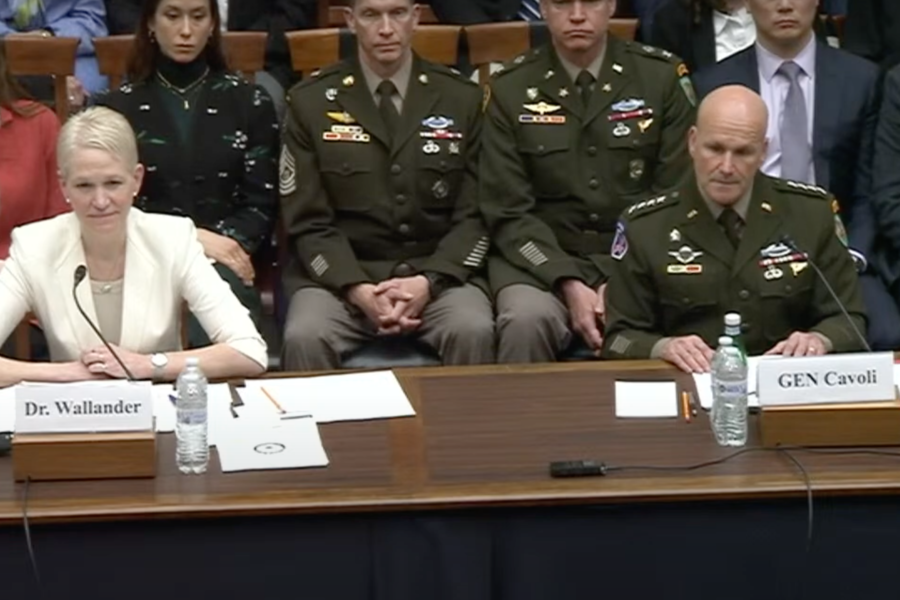The Pentagon’s top civilian and military leaders for Europe reiterated to Congress that providing modern Western fighter jets like the F-16 to Ukraine is not an immediate priority for the Department of Defense—even as they warned that Russia’s air force remains a serious threat to the region.
Testifying to the House Armed Services Committee on April 26, Gen. Christopher Cavoli, head of U.S. European Command, and Dr. Celeste Wallander, assistant secretary of defense for international security affairs, held firm on DOD’s stance that the U.S. needs to prioritize Ukraine’s most urgent needs in its fight against Russia, and those needs don’t include advanced airpower.
“Our focus has been on … Ukrainian priorities for the fight, and aircraft, while on the list, Western modern aircraft is about eighth on the list,” Wallander said. “And so we have focused with resources on the highest priority capabilities, and that has been air defense, artillery, and armor.”
Wallander also argued that the time it would take to deliver Western fourth-generation fighters and train the Ukrainians on them would be too long for their current fight, an argument other Pentagon officials have also made.
Instead, Wallender and Cavoli touted the recent transfer of Soviet-era fighters from Slovakia and Poland to Ukraine, saying those jets could be quickly integrated into operations.
“Legacy Soviet aircraft have been helpful to the Ukrainians because their pilots are trained on those aircraft, they know how to use them, they know how to maintain them,” Wallander said.
Cavoli also seemed to indicate Ukraine doesn’t need F-16s to deny Russia air superiority.
“In the near term and into the mid-term, what Ukraine really needs to do is control the airspace over its country and over its forces,” Cavoli said. “And they’ve been doing that very effectively with ground-based air defense. So that’s the thing that’s most imperative right now, and it’s been very well served by ground-based air defense.”
Rep. Chrissy Houlahan (D-Penn.), an Air Force veteran, pushed back, noting that the conflict in Ukraine has lasted far longer than expected and shows no sign of letting up—while the question of F-16s has been debated for months now.
“The Congress has at least been asking that question officially since last April. So it’s been more than a year,” Houlahan said. “And I understand that these timelines are long, and it’s very expensive and prioritization, but we have no indication necessarily that this is going to abate anytime soon. And so it just feels as though it’s still an appropriate conversation to continue to ask and to continue to have.”
Russian Air Force
Wallander cautioned against dismissing the Russian Air Force. When Rep. Mike Waltz (R-Fla.) argued the damage done to Russia’s forces in Ukraine has been such that other NATO allies would be able to handle any Russian aggression, Wallander disagreed.
“I don’t think I would agree with you, with respect, Congressman, because Russia still retains strategic capabilities, an Air Force, cyber,” Wallander said.
“Its Air Force can’t establish air superiority in Ukraine,” Waltz replied. “I can’t imagine it establishing air superiority in Poland.”
“We should not make the mistake of underestimating Russia’s military capabilities, because the stakes of getting it wrong are too high,” Wallender said.
Cavoli echoed that point late in the hearing, as he described jhow Russia has been able to wield power in Europe through energy supplies, cyberattacks, and even conventional forces.
“The Russian ground force has been degenerated somewhat by this conflict—although it is bigger today than it was at the beginning of the conflict,” Cavoli noted. “The air force has lost very little. They’ve lost 80 planes. They have another 1,000 fighters and fighter bombers. The Navy has lost one ship. So they still use all of that conventional power as well, and they mix them all together.”

